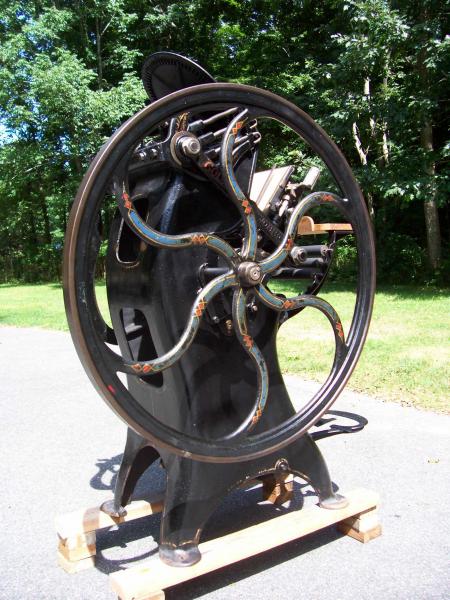Golding Jobber decoration uncovered
I purchased this Golding Jobber No 6 press without a clue that it had this original decoration beneath dirt, ink, and paint. When I discovered there was something there, I took my time and slowly removed what I could to preserve what remained. Here is the results of my effort. The press finish is about 90% original. I did not retouch any of the pinstripping and decorations. What you see is what was original to the press. I did have to replace some parts that were broken or had welds. Fortunately none involved the decoration. I thought some of you might enjoy seeing a nice original as much as I do.

flywheel side 2.jpg

Oiler side 2.jpg
It’s beautiful! What a thrill to find that under all the years….
That is very nice. Golding really had some good people doing their pinstripe work!
Daniel Morris
The Arm Letterpress
Brooklyn, NY
That’s awesome!
I recently completed the restoration of a Golding Jobber #6 from 1896 and unfortunately as I scraped away the tan paint that covered the original finish, I saw the very faint remnants of the original pinstriping and accents of the press that I was unable to salvage. I searched the internet to find photos of the way it looked originally without any luck because I’d like to restore the pinstriping as well.
What a great find on your press!
Anitsirk,
Thanks. This one is a March/April 1887 manufacture. I sent Steve O Saxe an email and he sent me some information, but, there is not much out there. There certainly was more than one design and person enhancing the appearance of the Golding presses. This press appears to have gotten more than most. There are many areas on this press that had pinstripping, but, was mostly worn away, and not evident in the photos. The flywheel was the best part having decoration on both sides. It also was installed backwards which may have helped keep the good side from getting lost. By the way, if you have any issues with your press, I parted out an 1888 and have many good parts left over after finishing this press.
This is amazing, how did you remove the paint on top without ruining what was underneath. I have a pearl to clean and I would love to get mine looking as beautiful as yours!
Hello,
First I would recommend trying to be sure there is something to save. I also have a Pearl and it doesn’t appear to have had any decoration on the original finish. I treated that press totally differently. If you do find something is there, here is the sequence I used. I first tried different chemicals, mineral spirits, lacquer thinner, etc. while they all removed dirt and ink, they were not effective on the paint job that also covered the original finish. I did not feel paint remover was safe as it would put the underlying finish at too high a risk. I found that very careful scraping with a wood chisel worked quite well. The paint that had to be removed, did not have good adhesion to the underlying finish. It came off with light pressure and didn’t take off the factory finish. The press probably did not get very good preparation before it was repainted. After I removed as much of the newer paint as I good, I lightly rubbed it down with mineral spirits. At this point the old finish did not look very good even though the decorations were uncovered. The original black paint looked gray because of the scrapping and there were a number of places where the finish was gone completely. At this point, I sprayed all the painted areas with clear acrylic spray paint. It protects the worn areas from rust, while enriching the black and protecting the decorations. I hope this helps.
Hopefully it’s not to late but if you could take detailed photos of the decoration I’d love to have them in the hopes of recreating it on my #7
John -
Very interesting story about discovering the detail under the old paint. - And great to see it so well restored.
I have an 8x12 jobber here that came from CT and bears a label identifying it as being restored by Otto Lawson in CT. Looks like the ‘restoration’ was done quite a while ago.
Got any info on Otto Lawson and his work with these jobbers?
Also - I had an inquiry this morning for a treadle for a Pearl Improved No 11. Any suggestions on that one? (Besides contacting you and Mike Anton, that is…)
Thanks.
Alan
Hi Alan,
I have not heard of Otto Lawson I’m afraid. Even though I’m an old guy, I didn’t discover my love of the printing machinery until recently, so I don’t have knowledge of what took place here in past years. Sounds like another Swede like me though. Your CT Jobber sounds maybe like the one retrieved on the CT coast when Paul Aken was on his way to deliver my No 18 from Maryland and stopped to chat with you. I sold my last Pearl No 11 treadle a couple months ago. I found a stash of 6, but, they didn’t last very long. I do have a nice set of original delivery board brackets and a complete brake assembly left. Also, I’m looking for a complete fountain less the gooseneck for the Jobber No 6 if you ever hear of a source for one.
John
can you post a detail picture thanks !!
Does anyone know how often Golding changed their decoration or if it was different by model?
Seems to me Goldings run in reverse direction from CP or I’ve been doing it all wrong since WWII. Something to do with the dwell of the platen! That would account for your thought of your fly wheel being on backward!